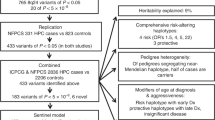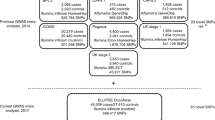Abstract
Despite evidence that prostate cancer has a genetic etiology, it has been extremely difficult to confirm genetic linkage results across studies, emphasizing the large extent of genetic heterogeneity associated with this disease. Because prostate cancer is common—approximately one in six men will be diagnosed with prostate cancer in their life—genetic linkage studies are likely plagued by phenocopies (i.e., men with prostate cancer due to environmental or lifestyle factors), weakly penetrant alleles, or a combination of both, making it difficult to replicate linkage findings. One way to account for heterogeneous causes is to use clinical information that is related to the aggressiveness of disease as an endpoint for linkage analyses. Gleason grade is a measure of prostate tumor differentiation, with higher grades associated with more aggressive disease. This semi-quantitative score has been used as a quantitative trait for linkage analysis in several prior studies. Our aim was to determine if prior linkage reports of Gleason grade to specific loci could be replicated, and to ascertain if new regions of linkage could be found. Gleason scores were available for 391 affected sib pairs from 183 hereditary prostate cancer pedigrees as part of the PROGRESS study. Analyzing Gleason score as a quantitative trait, and using microsatellite markers, suggestive evidence for linkage (P-value ≤ 0.001) was found on chromosomes 19q and 5q, with P-values ≤ 0.01 observed on chromosomes 3q, 7q, and 16q. Our results confirm reports of Gleason score linkage to chromosome 19q and suggest new loci for further investigation.



Similar content being viewed by others
References
Abecasis G, Cherny S, Cookson W, Cardon L (2002) Merlin-rapid analysis of dense genetic maps using sparse gene flow trees. Nat Genet 30:97–101
Albertsen PC, Hanley JA, Barrows GH, Penson DF, Kowalczyk PD, Sanders MM, Fine J (2005) Prostate cancer and the Will Rogers phenomenon. J Natl Cancer Inst 97:1248–1253
Camp NJ, Farnham JM, Cannon Albright LA (2005) Genomic search for prostate cancer predisposition loci in Utah pedigrees. Prostate 65:365–374
Chang BL, Isaacs SD, Wiley KE, Gillanders EM, Zheng SL, Meyers DA, Walsh PC, Tren JM, Xu J, Isaacs WB (2005) Genome-wide screen for prostate cancer susceptibility genes in men with clinically significant disease. Prostate 64:356–361
Easton DF, Schaid DJ, Whittemore AS, Isaacs WJ (2003) Where are the prostate cancer genes? A summary of eight genome wide searches. Prostate 57:261–269
Elston RC, Buxbaum S, Jacobs KB, Olson JM (2000) Haseman and Elston revisited. Genet Epidemiol 19:1–17
Epstein J, Carmichael M, Partin A, Walsh P (1993) Is tumor volume an independent predictor of progression following radical prostatectomy? A multivariate analysis of 185 clinical stage B adenocarcinomas of the prostate with 5 years of followup. J Urol 149:1478–1481
Etzioni R, Penson DF, Legler JM, di Tommaso D, Boer R, Gann PH, Feuer EJ (2002) Overdiagnosis due to prostate-specific antigen screening: lessons from U.S. prostate cancer incidence trends. J Natl Cancer Inst 94:981–990
Janer M, Friedrichsen DM, Stanford JL, Badzioch MD, Kolb S, Deutsch K, Peters MA, Goode EL, Welti R, DeFrance HB, Iwasaki L, Li S, Hood L, Ostrander EA, Jarvik GP (2003) Genomic scan of 254 hereditary prostate cancer families. Prostate 57:309–319
Jemal A, Siegel R, Ward E, Murray T, Xu J, Smigal C, Thun M (2006) Cancer statistics. CA Cancer J Clin 56:106–130
Lerner SE, Blute ML, Bergstralh EJ, Bostwick DG, Eickholt JT, Zincke H (1996) Analysis of risk factors for progression in patients with pathologically confined prostate cancer after radical retropubic prostatectomy. J Urol 156:137–143
Matsui H, Suzuki K, Ohtake N, Nakata S, Takeuchi T, Yamanaka H, Inoue I (2004) Genomewide linkage analysis of familial prostate cancer in the Japanese population. J Hum Genet 49:9–15
Neville PJ, Conti DV, Paris PL, Levin H, Catalona WJ, Suarez BK, Witte JS, Casey G (2002) Prostate cancer aggressiveness locus on chromosome 7q32–q33 identified by linkage and allelic imbalance studies. Neoplasia 4:424–431
Neville PJ, Conti DV, Krumroy LM, Catalona WJ, Suarez BK, Witte JS, Casey G (2003) Prostate cancer aggressiveness locus on chromosome segment 19q12–q13.1 identified by linkage and allelic imbalance studies. Genes Chromosomes Cancer 36:332–339
O’Connell JR, Weeks DE (1998) PedCheck: a program for identification of genotype incompatibilities in linkage analysis. Am J Hum Genet 63:259–266
Ostrander EA, Stanford JL (2000) Genetics of prostate cancer: too many loci, too few genes. Am J Hum Genet 67:1367–1375
Paiss T, Worner S, Kurtz F, Haeussler J, Hautmann RE, Gschwend JE, Herkommer K, Vogel W (2003) Linkage of aggressive prostate cancer to chromosome 7q31–33 in German prostate cancer families. Eur J Hum Genet 11:17–22
Pal P, Xi H, Kaushal R, Sun G, Jin CH, Jin L, Suarez BK, Catalona WJ, Deka R (2006) Variants in the HEPSIN gene are associated with prostate cancer in men of European origin. Hum Genet 120:187–192
SAGE (2004) Statistical analysis for genetic epidemiology. Statistical Solutions Ltd, Cork
Schaid D (2006) Pooled genome linkage scan of aggressive prostate cancer: results from the International Consortium for Prostate Cancer Genetics. Hum Genet 120:471–485
Sengupta S, Slezak JM, Blute ML, Leibovich BC, Sebo TJ, Myers RP, Cheville JC, Bergstralh EJ, Zincke H (2006) Trends in distribution and prognostic significance of Gleason grades on radical retropubic prostatectomy specimens between 1989 and 2001. Cancer 106:2630–2635
Slager S, Schaid D, Cunningham J, McDonnell SK, Marks AF, Peterson BJ, Hebbring SJ, Anderson S, French AJ, Thibodeau SN (2003) Confirmation of linkage of prostate cancer aggressiveness with chromosome 19q. Am J Hum Genet 72:759–762
Slager SL, Zarfas KE, Brown WM, Lange EM, McDonnell SK, Wojno KJ, Cooney KA (2006) Genome-wide linkage scan for prostate cancer aggressiveness loci using families from the University of Michigan prostate cancer genetics project. Prostate 66:173–179
Stanford JL, McDonnell SK, Friedrichsen DM, Carlson EE, Kolb S, Deutsch K, Janer M, Hood L, Ostrander EA, Schaid DJ (2006) Prostate cancer and genetic susceptibility: a genome scan incorporating disease aggressiveness. Prostate 66:317–325
Thompson IM, Canby-Hagino E, Lucia MS (2005) Stage migration and grade inflation in prostate cancer: Will Rogers meets Garrison Keillor. J Natl Cancer Inst 97:1236–1237
Witte J, Goddard K, Conti D, Elston RC, Lin J, Suarez BK, Broman KW, Burmester JK, Weber JL, Catalona WJ (2000) Genomewide scan for prostate cancer-aggressiveness loci. Am J Hum Genet 67:92–99
Witte JS, Suarez BK, Thiel B, Lin J, Yu A, Banerjee TK, Burmester JK, Casey G, Catalona WJ (2003) Genome-wide scan of brothers: replication and fine mapping of prostate cancer susceptibility and aggressiveness loci. Prostate 57:298–308
Zeger SL, Liang KY, Albert PS (1988) Models for longitudinal data: a generalized estimating equation approach. Biometrics 44:1049–1060
Acknowledgments
We especially thank the members of the PROGRESS families for participating in this research. This research was supported by National Institutes of Health Grants RO1 CA080122 (to J.L.S.), RO1 CA78836 and KO5 CA90754 (to E.A.O.), and the Department of Defense fellowship W81XWH-04-1-0083 (to D.M.K.), with additional support from the Prostate Cancer Foundation and the Fred Hutchinson Cancer Research Center. E.A.O was supported in part by the Intramural Program of the National Human Genome Research Institute.
Author information
Authors and Affiliations
Corresponding author
Rights and permissions
About this article
Cite this article
Schaid, D.J., Stanford, J.L., McDonnell, S.K. et al. Genome-wide linkage scan of prostate cancer Gleason score and confirmation of chromosome 19q. Hum Genet 121, 729–735 (2007). https://doi.org/10.1007/s00439-007-0368-5
Received:
Accepted:
Published:
Issue Date:
DOI: https://doi.org/10.1007/s00439-007-0368-5




